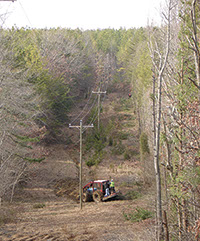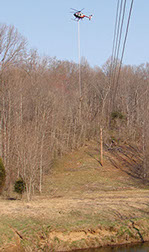


SEARCH MyCVEC
CVEC's Right of Way Procedure:
CVEC clears the corridor beneath and around its power lines to keep the lights on and to keep your family and your line crews safe and sound. This practice is known as right-of-way (or ROW) management.
You will likely see ROW crews once every five years in your neighborhood, trimming mature trees or removing young saplings so that they will not grow into the wire zone of the distribution power lines.
The co-op utilizes an Integrated Vegetation Management (IVM) program to maintain the ROW. IVM is defined by the EPA as “the practice of promoting desirable, stable, low-growing plant communities --- that will resist invasion by tall-growing species --- through the use of appropriate, environmentally sound, and cost-effective control methods."
Adopting IVM on ROW can:
![]() Improve transmission reliability
Improve transmission reliability
![]() Reduce vegetation management costs
Reduce vegetation management costs
![]() Reduce utility customers’ costs
Reduce utility customers’ costs
![]() Improve native plant and songbird habitat
Improve native plant and songbird habitat
![]() Provide other ecological benefits (IE: reduce runoff, control invasive species, etc.)
Provide other ecological benefits (IE: reduce runoff, control invasive species, etc.)
Controlling Tree Growth BELOW the Power Line
 CVEC maintains right-of-ways utilizing the following methods:
CVEC maintains right-of-ways utilizing the following methods:
1. Bush Hogging & Chainsaw Work:
About every five years, we may pass through with a tractor and bush hog to knock down saplings and reduce the vegetation to a height where repair crews will be able to reach that section of the power line corridor. This practice is effective, but never ending. The tree roots remain, issuing suckers that grow quickly into trees.
Where mature trees are present, CVEC may find it necessary to trim and/or lower the overall height of the tree. This will allow 5 years of growth for the tree and ensure reliable service for you and your neighbors.
Helicopter "Side Walling":
To trim lateral branches from trees in difficult terrain and remote
places, CVEC brings in a special tree trimmer with a helicopter. Attached to it is a set of 10 circular
blades suspended from the bottom of a helicopter.
2. Self Maintenance
If you have your land in agricultural production or some other activity that keeps growth down in the ROW corridor, then CVEC will bypass that section and move on.
 Hunt groups and nature enthusiasts often use a right-of-way to create a specific habitat for songbirds, butterflies, wild turkeys, quail, and deer. If you have an area of land beneath the power line that you think would be suitable for such a habitat ... or planting a food plot, keeping a raspberry patch or grazing goats, a good time to start that project would be immediately after CVEC has cleared the ROW.
Hunt groups and nature enthusiasts often use a right-of-way to create a specific habitat for songbirds, butterflies, wild turkeys, quail, and deer. If you have an area of land beneath the power line that you think would be suitable for such a habitat ... or planting a food plot, keeping a raspberry patch or grazing goats, a good time to start that project would be immediately after CVEC has cleared the ROW.
3. Habitat Conversion
Where possible, CVEC will be working to convert the ROW from a corridor dominated by trees to one that features low growing shrubs and native plants, creating a meadow environment.
CVEC utilizes an herbicide that is spot-sprayed on the green leaves of each sapling in the ROW. This inhibits the tree’s natural enzymes, preventing additional growth and starving the root system. When new plant growth begins, the ROW habitat conversion is underway.
Controlling Tree Growth BESIDE the Power Line
 Trees bordering the right-of-way corridor will develop lateral branch growth toward the power lines and into the ROW. If left uncontrolled, branches can cause power outages and make it difficult for repair crews to work during restoration efforts. Momentary contact with the power line will cause a temporary fault, resulting in a power “blink” that resets your clocks.
Trees bordering the right-of-way corridor will develop lateral branch growth toward the power lines and into the ROW. If left uncontrolled, branches can cause power outages and make it difficult for repair crews to work during restoration efforts. Momentary contact with the power line will cause a temporary fault, resulting in a power “blink” that resets your clocks.
CVEC controls lateral tree growth by “sidewalling” on a twenty-year cycle through a number of methods.
Traditionally, side-walling is performed with mechanical cutters that move along the right-of-way. Manual trimming is impractical and is both time consuming and dangerous.
A second method is aerial trimming, performed by a helicopter that follows the tree line and trims the lateral branch growth with rotary blades. This method is very effective, particularly in the mountains and over areas with surface water.
Controlling Yard Tree Growth
Remember to look up when you are planting trees in your yard. If you select a planting location that will allow that tree to grow up and into a power line, it would be wise to consider a different location.
![]() Go here to find a chart that suggests the best trees/shrubs & the safe distance to plant eachIf you have a yard tree that needs to be trimmed because it is approaching the power line or may fall into a power line, then there are several options:
Go here to find a chart that suggests the best trees/shrubs & the safe distance to plant eachIf you have a yard tree that needs to be trimmed because it is approaching the power line or may fall into a power line, then there are several options:
1. If the tree is approaching or threatening a single phase or three-phase power line that delivers power to you and your neighbors, CVEC will trim the tree to allow 5 years of growth before additional trimming is necessary. If you decide to trim or cut down a tree in your yard, give us a call. CVEC will temporarily drop the service line to your home if it will help you or the aborist working on the tree.
2. If trimming is not a suitable solution and you choose to have the tree removed at CVEC’s suggestion, then you would qualify for the CVEC Tree Replacement Program.
 Yard Tree Replacement: This is a special program for yard trees growing up and into CVEC power lines that would otherwise require trimming to prevent power outages and safety hazards. Call CVEC to determine if there’s a tree in your yard that qualifies. If it does, CVEC will cut down the tree, chip the brush, and provide a gift card to allow you to purchase a suitable tree to be planted away from the ROW.
Yard Tree Replacement: This is a special program for yard trees growing up and into CVEC power lines that would otherwise require trimming to prevent power outages and safety hazards. Call CVEC to determine if there’s a tree in your yard that qualifies. If it does, CVEC will cut down the tree, chip the brush, and provide a gift card to allow you to purchase a suitable tree to be planted away from the ROW.
Danger Trees
 On a daily, year-round basis, CVEC employees look for "danger trees" ... dead or diseased trees that threaten the power lines.
On a daily, year-round basis, CVEC employees look for "danger trees" ... dead or diseased trees that threaten the power lines.
We ask our members to alert us about such trees. If you see a tree threatening CVEC's lines, contact [email protected] with your contact info and the location of the threatening tree. We also would love to get a photo if you would like to share.
Home
Top of page
HOME | REPORT AN OUTAGE | PAY MY BILL | CONTACT CVEC
Phone: 434.263.8336 | Toll free: 800.367.2832 | Fax: 434.263.8339
Corporate Headquarters:
800 Cooperative Way
Arrington, VA 22922
Payments:
Dept. 1340 | PO Box 2153
Birmingham, AL 35287-1340
Correspondence:
P. O. Box 247
Lovingston, VA 22949
